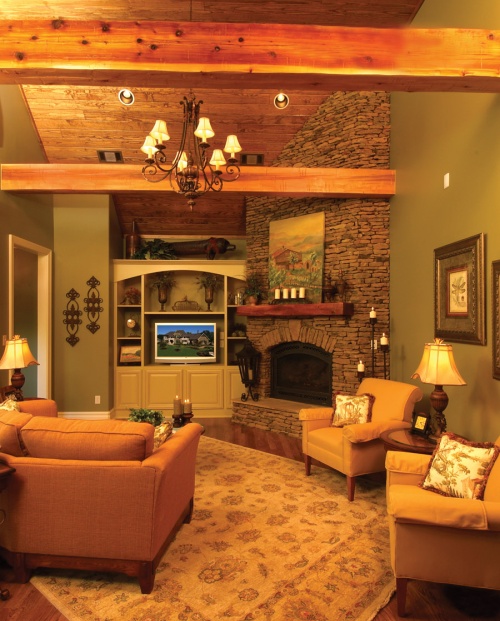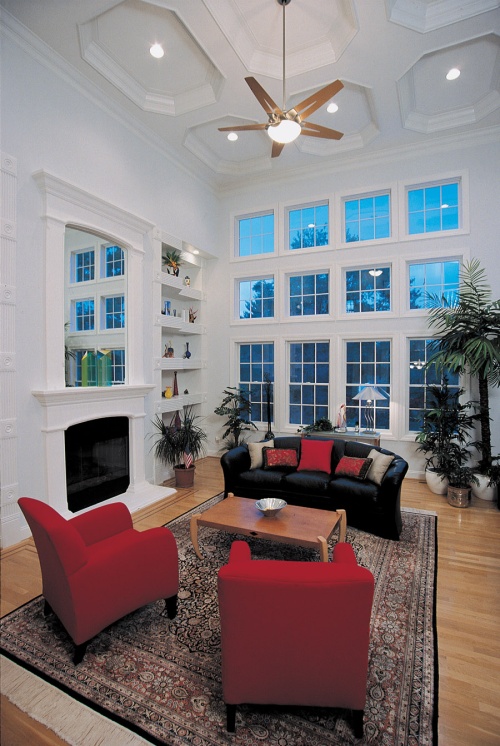
Moving into a new home is incredibly exciting. The interior decorating is fresh and full of possibilities. You can do anything you want!
However, once all the furniture starts to come into the house, without a plan in mind, the task of finding a place for every possession can be daunting: How in the world will that couch fit anywhere? What about all these knick-knacks? The bookshelf is a lot taller than I remember! To ward off any potential panic, before moving day it's important to get a grip on all the possessions and the best resting place for each.
View this House Plan
View Other Ranch House Plans
The first place to start is to know the common mistakes. Once aware, it's much easier to avoid making them:
No Man's Land – You know that room with every piece of furniture flush against the wall? Is that a room of comfort and style in your memory? No? Not surprising! Though it's a simple way out, placing all furniture against a wall often creates an empty zone in the middle of a room. Though it may be played off as "spacious," all that extra room puts too much air in between guests and inhibits easy conversation from flowing. Step away from the walls!
Peek-a-boo Points – It's always shocking to be settled into a room only to discover the couch being sat upon is blocking a lovely built-in fireplace or picture window with a stunning view. Homeowners make the mistake of fitting furniture in a "perfect" spot that actually hides an outstanding focal point. Your furniture may be lovely, but don't fight the room's built-in beauty for attention. After all, that view may spark conversation, your furniture is just being sat upon!
Goldilocks Syndrome – You all know the story of Goldilocks and the bears, right? Nothing was right for little Goldie! Everything was too hot, too cold, too hard, too soft, too big, too little, and on and on and on. It's surprising to see that some homeowners are following her lead with rooms full of too much furniture or too little and close to nothing! Rooms with too much furniture are overwhelming and crowded, making it difficult for guests to gather and relax. Too little furniture creates a cold atmosphere that's unwelcoming when visitors want to settle in and get cozy. It's hard to strike a balance, but also so important.
So now that we've identified some issues, it's time to address the solutions. It may be possible you're thinking that furniture placement is too demanding. You don't want too much or too little. Nothing can be too close or too spread out. You don't want to hide anything, but you want to find the perfect placement. Are we sure this is possible?!
It's all about thinking outside the box! Just as you take the opportunity to pick out unique curtains, carpeting, flatware, and other home accessories, it's important to allow that creativity to overflow into the mundane tasks like furniture placement:
View this House Plan
View Other Luxury House Plans
Pick a focal point- What grabs your attention when entering a room? The fireplace? The large windows? A large wall displaying your favorite artwork? Find that special something you want to showcase and make it the focus of the room. Arrange the furniture in a way that this focus can be appreciated from the majority of seating.
Traffic patterns- It's important to find the flow of traffic patterns and arrange your furniture around them. If you love your coffee table, but are consistently banging your knees against it, perhaps it should be placed at a different angle or in a room with less traffic flow. Keep in mind that 24-36 inches are recommended between the end of a couch, recliner, or other large pieces. 18 inches are needed to pass behind chairs. 30-36 inches are needed for walking paths. Don't block the natural entries to the space and avoid forcing detours or strange routes. On the other hand, it may ideal to reduce the number of straight paths in homes with small children and pets on the move. Straight paths encourage speed which may be disastrous for collectables and other displayed items.
Use multipurpose pieces- Storage ottomans and tables with drawers create storage but allow for simplicity in rooms. These are especially good suggestions for homes with the "too much" issues.
Work your way up- Remember to start with the biggest and most important pieces for a room. It's always easier to add more furniture than it is to try to eliminate pieces.
Variety is the spice- Take advantage of varying furniture heights to cluster some items and add detail to a room. Play up angles, corners, and diagonals when appropriate.
Natural divide- Sofa tables, plants, and coffee tables help to create natural divides of spaces without appearing intrusive and out of place. These small touches add greatly to the decor and atmosphere while serving many practical purposes.
To make the most of these suggestions, it's important to play with them ahead of time. Moving large furniture over and over is time consuming and exhausting. It will most likely end with frustration and the perfect placement may never be agreed upon. Avoid this disaster with a sheet of graph paper and some furniture cut outs. On a piece of graph paper, sketch out the shape of a room with a defined scale, for example, every one inch on graph is two feet in the actual space. After the room is outlined, marking all doors, windows, and other points of interest, create models for your furniture pieces from construction paper using the same scale.
View this House Plan
View Other Country House Plans
When all your pieces are ready, it's time to put together the puzzle! With this scaled down model of your room, you can try all kinds of furniture placement, easily figuring what will and will not work. Each time you find a placement you like, look at traffic flow and the room's use. Just because the pieces fit doesn't mean it's the best yet. If you get frustrated, take some time away from the puzzle. Once you have a plan that works, glue those pieces in their spots and note all measurements. Then on moving day, you have a prepared guide to what goes where exactly.
Though you may change your mind when the big day comes, having this outlined map of the room will keep you from moving everything over and over. Trying the possibilities in scale makes reality much more pleasant!


